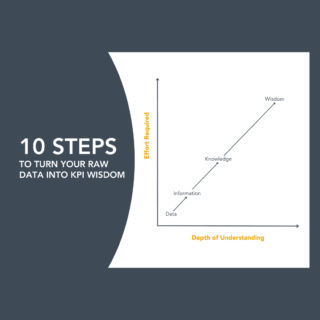Many people think that if we improve statistics, visualizations, and data then the use of our organization’s measures will improve as well. If only it was that easy. Ramping up the technological and technical aspects may improve things temporarily, but the key to deep and sustainable improvement of your measurement system is something else entirely.
The truth is that the technical parts of performance measurement don’t and won’t work very well unless we understand the role that humans play in the success of meaningful and well-used measurement.
People, People, People (as Brené Brown quips) will ultimately determine the effectiveness of our organization’s measurement system because measurement data is of no value without human involvement. It is human beings, not machines, who turn data into information, information into insights, insights into knowledge, knowledge into wisdom, and then, ultimately, into decision-making. Without humans, data is simply… well, data.
The impact of attitudes toward measurement
Our motivations and available energy for the activity of measurement are shaped by our attitudes and emotions. That is why negative feelings can cause such dysfunction within the measurement process itself and contribute to behavior contrary to what is in the best interest of the organization.
The good news is that attitudes and feelings are not permanent – They are changeable
When humans anticipate negative emotions around something, we tend to shy away from it. The reverse of course is also true. When we anticipate positive emotions around something, we become motivated to move towards it.
So, what’s love got to do with it?
Creating a positive emotional context for measurement has everything to do with it.
Start by considering the “context” in which the measurement system exists in your workplace. Do people see the incredible value proposition that doing measurement well delivers, or do they shy away from it, avoiding using measures at all cost?
4 Shifts to create positive space for measurement in your world
Shift to Positive #1: Build capability, not in isolation, but collectively
As humans, the more capable we feel, the more motivated we will be because capability makes us feel competent and confident. As psychiatrist David Krueger says: “The experience of mastery, of being effective may well be the most powerful motivating force in an individual’s work”. And the thing about performance measurement capability is that we are at our most capable when we bring out collective knowledge and skills together (Group Genius). There are a variety of skills and knowledge needed to do measurement well, but not everyone needs to be an expert in them all. When we understand the step-by-step process needed for measuring and achieving our strategy, then we know where to invest to close the measurement capability gaps within our teams and departments.
Shift to Positive #2: Build trust and reduce shame and fear
As humans, it’s our emotions that drive most of our behaviours, whether we are aware of their forces or not. Assuming that tightly connecting rewards to targets will create a positive context for measurement is misguided. Too often, it is the fear of failure and of punishment that drives dangerous dysfunction within our organizations. Without trust, people will game the system so that they minimize negative emotions and avoid accountability.
To build a trusting, positive environment without fear of reprisal, we need to use measures for their true purpose – and that purpose is for LEARNING about how our organization is performing. It’s not about judging if people are good or bad; right or wrong. Only when we have this psychologically safe environment for learning from our measures, can we focus where our energy is needed most (where performance is not improving). Leaders are able to empower teams to take action that moves them closer to achieving the better future outlined in their strategy. We call this truth-seeking.
Shift to Positive #3: Don’t do hard things alone – The power of collaboration
The well-known adage, “If you want to go fast, go alone; if you want to go far, go together” is incredibly relevant to performance measurement. To have enough capability, knowledge, buy-in and support, you must involve others throughout the measurement process. We may think that measurement is first a technical, static activity – of identifying standard measures, then collecting and analyzing data. Although this aspect is important, it will never deliver full value, until we realize and create the social process that is needed. By involving others, the measurement process may go a bit slower, but the resulting value of your time investment will be considerably higher.
Shift to Positive #4: Reduce command and control – Empower self-management
There is one “sure-fire” indicator that an organization’s context of measurement is shifting in a positive direction, and that is seeing teams succeed under self-management.
When people feel empowered to change (think athletes, coaches, trainers, investors), they commonly use measurement to help them, and then seek as much information as possible about how they are performing. The same can be true in workplaces. When employees feel empowered to improve their measures, their scorecards, and are involved in goal and target setting, and use them for learning about their work, motivation becomes intrinsic. They no longer rely on measures being “given to them from higher-up”, but instead are determining at least some of what should be measured, to help them understand, manage, and improve the work they do.
In today’s complex, knowledge-driven and often virtual workplaces, self-management is essential to organizational success. Command and control approaches are no longer working. The shift to a more positive context starts with teams receiving the tools and information they need to better understand how they are performing – and that includes a reliable and non-judgmental measurement system that draws people towards using measures to improve.
Change Agents: a message of encouragement
You can do this. If you are trained in the performance measurement process called PUMP®, you already have so much to build upon. The change will be worth it. Don’t get discouraged. Start small, with teams and leaders who show interest in better strategy execution with the lens of meaningful measurement. Change happens over time. Recognize progress no matter how small or big and celebrate each improvement you see.
In my experience, measurement will absolutely be better than before when you build a positive context that motivates people to become involved.



